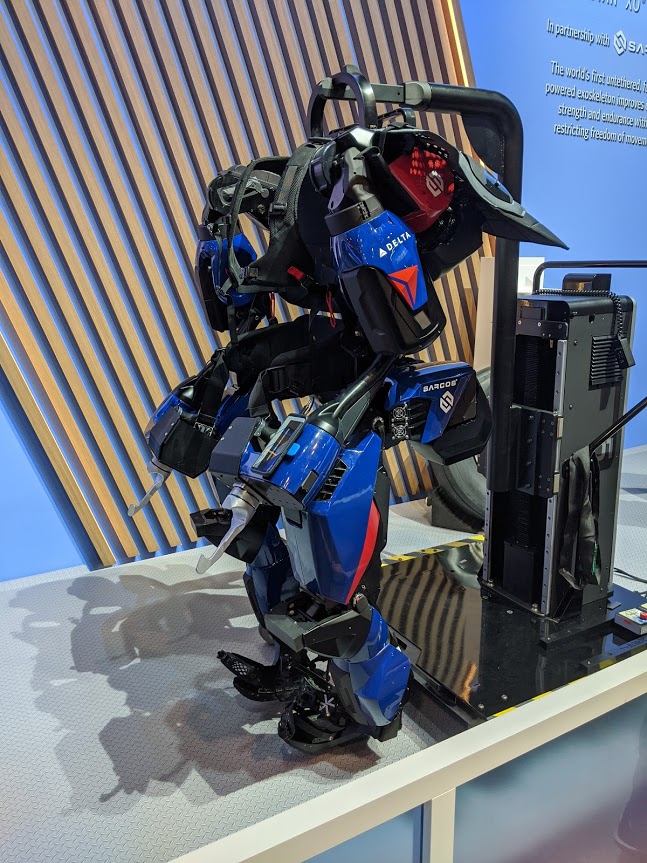Community, Leadership, Experimentation, Diversity, & Education
Pittsburgh Arts, Regional Theatre, New Work, Producing, Copyright, Labor Unions,
New Products, Coping Skills, J-O-Bs...
Theatre industry news, University & School of Drama Announcements, plus occasional course support for
Carnegie Mellon School of Drama Faculty, Staff, Students, and Alumni.
CMU School of Drama
Thursday, January 23, 2020
Sarcos offers fully mobile, insanely strong industrial exoskeletons
Ars Technica: The most interesting thing we saw at the Consumer Electronics Show this year was the back side of Delta Airlines' exhibit, where some Sarcos Robotics folks were putting the Guardian XO—a powered industrial exoskeleton—through its paces, and the adventurous (and patient) could wait for half an hour or so in line to operate one disembodied arm of the Guardian attached to a 50-pound suitcase.
Subscribe to:
Post Comments (Atom)

4 comments:
It's incredible that devices like this are beginning to make their way into large industries and companies. I find it especially encouraging that the robots are being used to aid human work rather than replace it altogether. That may be because the technology as is is easier to create since less intelligence is demanded of a human-operated machine than a robot that operates itself. But I choose to believe it's to allow those jobs to go to people that need them. It's also interesting to see that the company is willing to lease the XOs but not allow purchases. This is a good tactic for keeping their machines from being tampered with and repurposed for things they didn't intend. Allowing the general population or corporations to buy these could be dangerous given their strength and ability to be misused. The possibility of extending the healthy careers of heavy lifting workers is also exciting. Both my grandparents on my dad's side worked in factories for decades so I've personally seen the toll manual labor jobs put on the physical form. The potential of widespread use of XOs in the future would be so beneficial to so many individuals.
What an incredible technical innovation. Exoskeletons like this have been present in science fiction for ages, but an actual practical working model has been absent from the world, until now. The video demonstration was an amazing proof of concept. The way he was able to lift the fifty-pound suitcase straight out in from of him as if it were no more than a measly sheet of paper. But what are the implications of such a practical invention? The article gave great examples – allowing heavy lifters to work longer without throwing out their backs, assisting in construction, and more. But how can this be implemented in other fields, for instance, in theatre? For one, it can assist in the process of throwing weight on fly arbors, though that ties back in with lifting. Perhaps it can be used in moving around large set pieces more efficiently and effectively – though again, this goes back to lifting. Granted, that is exactly what this exoskeleton is designed for, so it would be doing its job. It will be interesting to see where exactly this the will be widely implemented. It will also be interesting to see how this tech will evolve, as in, what other features will be implemented into its functionality, if anything? Or will the only advancements made be increasing its weight capacity?
Woah… okay. Well. I'm looking forward to riding my robot horse in my mech suit, I guess. The future is pretty wild, and it also seems to be the present. I can’t imagine how this is going to transform all sorts of industries as exoskeletons become affordable and widespread, and especially as their manual dexterity increases. It's hard to get a feel for how nimble the hands are, but if this gets good enough, it could allow even complex tasks to be performed in awkward positions or with heavy or dangerous components. The other interesting direction I think this could take is remote control. An exoskeleton-like interface combined with remote control could allow performance of specialized tasks in hazardous environments by people relatively untrained in operating a robot. If all they have to do is work with their hands like normal, any sort of necessary specialist could be brought into a disaster site safely.
This is incredible. I think it's great that technology like this is being integrated into industries where workers would benefit in the sense that heavy lifting every day won't drastically injure them. I actually know someone personally, who ended up retiring after about 15 years of working in construction because he injured his back so badly, he could barely stand up or sit down without assistance. I would love to see more videos and articles about how this technology is improving, and I hope it won't be long before we see exoskeletons such as these in companies all over the country if not the world. Technology like this is someone life and world changing. Just imagine how efficiently jobs could be completed and how much more beneficial it would be for workers if this technology was available to many more consumers. I'm very interested in how this technology will evolve and how the exoskeleton will be improved over time.
Post a Comment